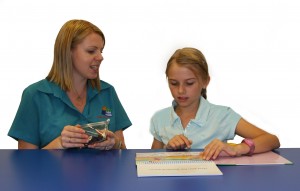
Using descriptive language is often difficult for children with language delays and disorders. Understanding descriptive language helps with comprehension of both spoken language and written information. Using descriptive language well helps with giving clear and specific instructions and with writing more interesting stories and more precise non fiction texts. Descriptive writing uses adjectives (which describe nouns) and adverbs (which describe verbs).
The acronym SCUMPS is useful for helping children use descriptive language. It stands for:
- Size
- Colour
- Use
- Material
- Parts
- Shape
Adjectives describe nouns (things and people) and can include: shape, colour, appearance, quality, sound, number, taste, texture, size and more. For a detailed list of adjectives click here.
Adverbs describe actions and can include: how, where, when, and why things are done. For a full list of adverbs click here.
Here are some ideas for developing descriptive oral language:
Feely bag. Place a number of objects in a bag. Ask your child to close their eyes and choose an object. Feel it while keeping the object inside the bag and describe it’s size, shape and texture. What might it be made of? What do they think it is used for? Are their different parts to it? Can someone guess what it is from the description?
Eye describe. Play this game in the car or around the house. Like eye spy choose something you can see and describe it and see who can guess what it is. Use the SCUMPS list as a help to give clues.
Descriptive barrier games. Use barrier games as discussed previously but make a rule that you cannot say the name of any of the objects, rather you need to describe them e.g. put the apple next to the banana might be “put the round red fruit next to the long yellow fruit”. For more information and some barrier games to download and print click here.
Character profiles. Cut some interesting photos of people from magazines or from clip art sites on the web. Give a description of your character including what they look like but also what you think their personality might be and what job or hobbies they might have. Choose three or four characters and make a story about them.
One guess who. Use cards for the traditional guess who game or use 10 or more pictures of people from magazines or clip art (if you do this you will need to name them). Spread your cards face up on the table. Choose a person and give a detailed description of them and see if your partner can guess who they are in one single guess. Try using pictures of places to play “one guess where” or pictures of objects to play “one guess what”.
Try these activities to develop descriptive language in written tasks:
Sentence builder. Write a simple sentence onto a piece of paper and cut up into individual words. Take turns to add a descriptive word or phrase to the sentence to make it longer and more interesting. e.g. “the boy ate apples, the little boy ate apples, the little boy ate four apples, the little boy ate four red apples, the little boy ate four red apples under the tree…” How long can you make your sentence?
Story change. Choose a passage from a book or magazine. If it is from a book make a copy. Use a highlighter to mark all the descriptive words. Change each descriptive word to something different. How does the story change? Can you use descriptive words to make the story scary or funny?
Story builder. Write about 10 to 12 descriptive words on cards and place them face down on the table. Use the links above for ideas and choose words suitable for your child’s language level. One person chooses a card and writes a sentence on a piece of paper to begin the story, but must include that word in the sentence. The next person chooses another word and writes a sentence to continue the story. How can you change your story by changing the descriptive words. Make lists of words to make certain types of stories such as scary or funny ones or ones about your child’s interests.
To help your child use more descriptive language in their school work:
- Make lists of adjectives and adverbs and keep them on the desk as you write. Use the links above for words to put in your lists.
- At the drafting stage of writing mark the important verbs and nouns and then see if you can add a descriptive word or two to each one to make work more interesting.
- Talk about the adjectives and adverbs in things that your child reads and how they add extra information and interest to the text.
We hope you have fun with these activities
Related Blog Posts
If you liked this post you may also like:
Barrier games for fun learning!
Speech Pathology 101
50 ready to read ideas
Play and floortime



